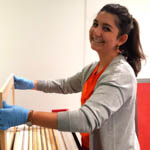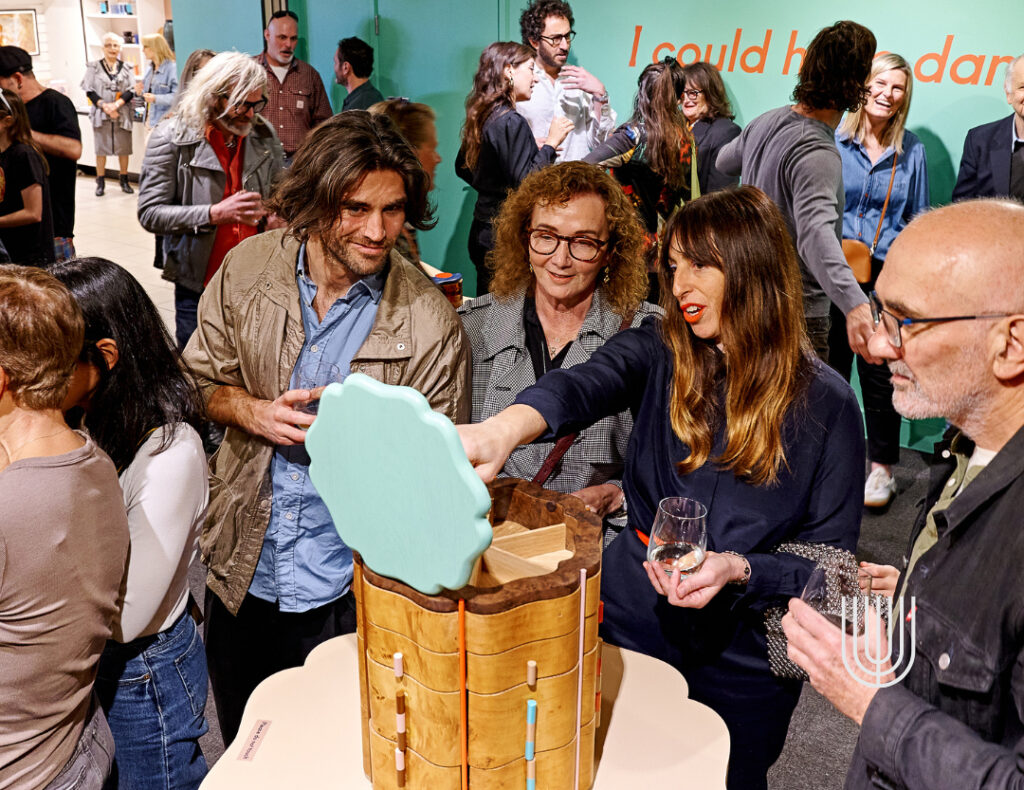
Iris Saar Isaacs, Three Mezuzot: Home is where the heart is – My home is my fortress – There’s no place like home, 2006-2007, Melbourne, Australia; Resin, acrylic, feathers, sterling silver, 140 x 35 x 35mm; Jewish Museum of Australia Collection 12903; © Iris Saar Isaacs
Elisa Ronzoni writes about the mezuzah as a device that turns the home into a sacred space.
We’d probably all agree that a temple is both a physical and spiritual space, representing more than just a sacred building—it’s a connection to something greater, it’s silence to delve deeper into the purpose of our lives. Joseph Campbell said it quite beautifully: “Your sacred space is where you can find yourself again and again.”
We like to think that the Jewish Museum of Australia offers exactly that, a safe and welcoming place for everybody to explore history, identity, community, art and craftmanship. In our galleries, people can contemplate, learn, connect and create in a spirit of curiosity and tolerance, ultimately finding a bit of themselves through participation.
In one of our galleries, we have the privilege of displaying two elegant and meaningful creations of Melbourne-based, established interior designer Danielle Brustman, a talented recipient of the JMA 2024 Eva and Marc Besen Contemporary Artist Commission.
Danielle’s practice spectrum is broad. She uses a vibrant and complex palette to create pieces that question how we perceive both private and public spaces. Her designs are shaped by storytelling and influenced by bold colour contrasts, geometric shapes, and imaginative environments.
- Danielle Brustman, Marta and Dora, install detail 2024, Melbourne; Courtesy of Dean Schmideg
- Danielle Brustman and guests at the opening of “I could have danced all night” August 2024, Melbourne; Courtesy of Dean Schmideg
In “I could have danced all night”, Danielle exhibits two intricately crafted boxes—one a music box, and the other a blend of jewellery and memory box. These objects are temples of detailed, personalized memories of the matriarchs in her family, Marta and Dora.
Marta is a music box informed by a 1960s handbag that Marta used to shop with. It is made of tortoiseshell acrylic, matte red acrylic, powder-coated aluminium, brass, and 3D printed carbon fibre-reinforced PA6 (Nylon 6).
Dora is a jewellery come memory box originating from Dora’s original vanity dresser. It is made of Birdseye Huon pine veneer on Tasmanian oak, original drawer fronts, American oak, MDF, American walnut burl veneer on birch plywood, Osmo Polyx-oil, oil-based paint, powder-coated aluminium, and glass mirror.
Aesthetically beautiful, these works are testimony of the added value provided by carefully selected materials and techniques, ultimately gifting the viewers not with merely aesthetically beautiful works, but with profound and resonating stories as well.
Storytelling is what we love to do the most, and the Jewish Museum of Australia Collection is home of thousands of objects that help us do just that. Many of these objects are handcrafted by ordinary people as well as established artists. Contemporary Judaica is a category well represented in our Collection and an exquisite example is the series of three Mezuzot by artist Iris Saar Isaacs.
The mezuzah (plural: mezuzot) is a small parchment scroll inscribed with specific Hebrew verses from the Torah, namely the Shema Yisrael prayer from the book of Deuteronomy (6:4-9 and 11:13-21). The scroll is inserted into a protective case that is affixed to the doorposts of Jewish homes and buildings as a sign of faith and a reminder of God’s presence.
Traditionally, a mezuzah is placed on the right side of the doorpost at an angle, with the top tilted inward toward the home. The verses emphasize love and commitment to God and the observance of His commandments. Homes ultimately become domestic temples.
Iris Saar Isaacs’ mezuzot are titled There’s no place like home, My home is my fortress, and Home is where the heart is. The base of each silver mezuzah is elliptical moulded resin with a hollow space to case the scroll. Each has a different surface covering: silver shards, acrylic rods, and feathers, respectively.
Borrowing these eloquent words from the artist’s statement:
“The mezuzah is placed on the threshold of the Jewish home, differentiating it from the outside world. Entryways are ambiguous and embody opposites: open and closed, entry and exit, inside and outside, microcosm and macrocosm, security and vulnerability. By creating these three mezuzot, I hope to introduce a fresh encounter and to engage the viewer on both visual and physical levels, questioning the purpose and meaning of home. I suggest that the home embodies three main functions: familiarity/ comfort, protection/ security and privacy/ seclusion. To connote familiarity/ comfort, I used feathers to represent a nest, where one feels ‘at home’, familiar, comfortable and nourished. The use of rods/poles represents a stronghold and a fortress, which evokes notions of fortification, protection and security. For the concept of privacy/ seclusion, I used ‘shutters’, which provide a shelter and a safe haven, screening the inner sanctum from the outside world.”
Thousands and thousands of people within and beyond the Jewish Community in Melbourne felt at home at the Jewish Museum of Australia over the fifty years of its activity and the thirty years in the current premises in Alma Road, St Kilda. As we prepare to celebrate our 30th anniversary next year, we feel ever so grateful and proud for the love and support received and shared, and we hope to continue to enhance our Collection with beautifully crafted objects.
About Elisa Ronzoni
 Hailing from Northern Italy where she completed her degrees in Museum Studies and Art History, Elisa Ronzoni fell in love with museum collections while in London, UK. In Melbourne since 2015, she is particularly drawn to social history collections and now proudly looks after the Jewish Museum of Australia’s holdings and catalogue.
Hailing from Northern Italy where she completed her degrees in Museum Studies and Art History, Elisa Ronzoni fell in love with museum collections while in London, UK. In Melbourne since 2015, she is particularly drawn to social history collections and now proudly looks after the Jewish Museum of Australia’s holdings and catalogue.



